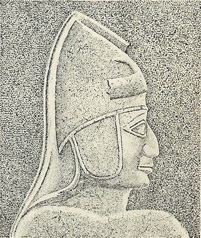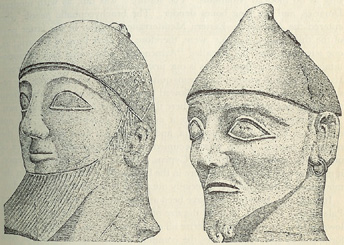|
(Chapter V, section 2)
The age of metal began in Egypt and Mesopotamia early in the fourth millennium B.C., and by 3000 B.C. it had spread to the Aegean and to Anatolia. Crete probably received metal age influences from Palestine and Egypt before most of the Anatolian mainland. Cyprus, which bears the same name as copper, was another early center. In the diffusion of early metal age culture westward along the Mediterranean and northwestward up the Danube the peoples of Asia Minor, Cyprus, Crete, and the Aegean Played an important role, acting as transmitters of impulses which had originated in Egypt and Sumeria. Let us first examine what Bronze Age skeletal material there is in Asia Minor. So far, all of it comes from two sites, Alishar Hüyük, which, in its later periods, was a Hittite city, and Hissarlik, the seventh level of Which was Homer’s Troy. Both were important centers in the Bronze Age. At Alishar, fifty-three skulls have been studied, from seven archaeological periods, ranging from the earliest Copper Age, dated from between 2600 and 2300 B.C., to the Osmanli invasion.2 Ten crania from the earliest period (two “Chalcolithic,” eight Copper Age) are uniformly Danubian in type, both metrically and morphologically. The small, high-vaulted, somewhat infantile dolicho- and mesocephalic form, with small face and mesorrhine to chamaerrhine noses, is no different from that found at roughly the same time at Anau, at Mariupol, in the Kiev Government, and in the Danube Valley, in association with Neolithic cultures. Two others, which are longer, may belong to a Megalithic or Corded variety.The unity of the early food-producing peoples on both sides of the Caucasus and Black Sea is therefore indicated, and from the racial standpoint, the Danubians could have come to central Europe from either South Russia or Anatolia, or both. In the second and third periods at Alishar, dated between 2300 and 1500 B.C., and called the Early Bronze Age, brachycephalic skulls appeared, and these persisted through the period of the Hittite Empire, for several centuries after 1500 B.C. The crania are large, low vaulted, and only moderately brachycephalic, with lambdoid flattening, and moderate browridges. The faces are of medium length, and narrow, although somewhat broader than those of the earlier Danubian type. The stature of the one male observed was tall, 174 cm.3 Not all of the Hittite Empire crania are brachycephalic. A long-headed variety, which seems to have replaced or outnumbered the brachycephals by the time of the Phrygian invasions, is both longer and lower vaulted than the Danubian type of the Copper Age; it is characterized by a very prominent nasal skeleton of true Near Eastern form, with little nasion depression. Bas-relief sculptures of historic Hittites reproduce this hook-nosed, open-eyed type of countenance. The sequence of racial types in Asia Minor during the metal ages probably runs somewhat as follows: the earliest food-producing people were the same as those in western Turkestan and southern Russia. The latter probably came in earlier times from the highland belt of which Anatolia forms a part. Shortly before 2000 B.C., a moderately brachycephalic type, with tall stature, entered Anatolia from regions yet to be determined, followed by a low-vaulted, hawk-nosed Mediterranean form, which we have named Cappadocian,” and which is well known in the present day Near East. True Arrnenoids or Dinarics were not, apparently, common in early times.
The crania from both levels are small dolichocephals, of a Mediterranean type; they are delicate and feminine in aspect, and sexing is difficult. The nose is prominent, with a high root which often springs directly from glabella without nasion depression. Yet in many cases a break in the lateral profile is formed by a bulbousness of the forehead above glabella. The occipital development is great, and prognathism is not uncommon. The high-nosed Cappadocian element found in Alishar Hüyük from the time of the Hittite Empire onward was also, therefore, the prevailing racial type of at least one important city of Palestine during the same period. Four Bronze Age skulls, two each from the Mount of Olives and Aïn Jebrul, may be included in the same category.7 One brachycephalic skull, however, has been found in Bronze Age Palestine; in the cave of Umm Qatafa, in the Wady Khreitum.8 This belonged to an adolescent, presumably a male, with a vertical forehead, small browridges, and a vertical occiput. With him was a large, prognathous dolichocephal. These two were not buried in the cave, but had been trapped by a fall of rock. Returning to Megiddo, we are told that “the skulls from the Hyksos and Late Bronze Age burials differ markedly from the Early Bronze and Chalcolithic specimens, and altogether appear to form another major physical group.”9 What the features of this later group may have been, we cannot determine without further information. But we have one other indication of racial types in the Bronze Age Near East, and that is the pictures on Egyptian monuments, which almost without exception show western Asiatics as white-skinned, bearded, and aquiline-nosed. Some are blond, but most are brunet. After Alishar, our next good series of Near Eastern Bronze Age crania comes from Cyprus. The Bronze Age culture which flourished in this island is divided into three periods; Early, Middle, and Late Cypriote; from 3000—2100, 2100—1600, and 1600—1000 B.C.10 Three skulls from the early period include two brachycephals, which are too fragmentary for further study, and one high-vaulted mesocephalic example. In the early and middle periods combined, twenty skulls have been studied. Of these, forty per cent, mostly from the middle period, are brachycephalic.11 (See Appendix I, col. 20.) The population was clearly mixed, with a long-headed hook-nosed Hittite-like element, and a brachycephalic one. In the late Cypriote period, seventy per cent of forty-seven skulls were brachycephalic. The round-headed element was clearly on the increase during the Bronze Age, and it may have begun entering the island at any time between 3000 and 2100 B.C. Judging from the evidence of Asia Minor and Palestine, we may suppose that this took place nearer the late than the early date. At the end of the Bronze Age, iron-using invaders re-established dolichocephaly. The long-headed element in Bronze Age Cyprus was, apparently, the typical Cappadocian, or Near Eastern variety of Mediterranean. In the
The round-headed element in Cyprus, which appears identical with that from Alishar, is numerous enough to warrant statistical comparisons. Fürst calls the skulls Armenoid, and they do resemble Iron Age and modern Armenians quite closely in vault size and proportions, but the the faces and noses of the Cypriotes are smaller in both height and breadth. At the same time, they resemble modern Alpines in vault size, while the faces are narrower. The bloc of early brachycephals of western Europe and North Africa which includes Afalou, Ofnet, and the Borreby skulls is quite different, being much larger in vault size and in facial dimensions as well. The Cypriotes notably lack the heavy mandible of western European brachycephals. The position of the Cypriotes in the modern racial scheme falls into the brachycephalic group of moderate vault size, including Alpines, Armenoids, and Dinarics; the most notable feature is the small face, notable for its narrowness, and the light jaw. It is more like the modern Dinarics than anything else, since it diverges from the Armenian standard in the same way as do modern Albanians. The stature12 was tall, as with modern Dinarics, and the long bones slender. The brachycephalic people who entered the Anatolian—Eastern Mediterranean region in the latter part of the third millennium B.C. were, therefore, an early form of Dinaric; as, one suspects, were the so-called “Armenoids” who came into Mesopotamia at the same time. This is our first meeting with the Dinaric race. Its appearance in western Asia seems quite abrupt, but was probably the result of a gradual development, followed by an overflow or evacuation from the seat of its characterization. Where this may have been is still unknown. Nevertheless, we may eliminate a number of possibilities. It did not come from Egypt or Mesopotamia, and it could not have come from the northern steppes, which were occupied by dolichocephals. Its place of origin was probably not far from Cyprus. Despite the Anatolian evidence, it may have developed somewhere in the highlands of Asia Minor or in the mountains of Syria, for it is especially numerous in both these places today. It could not, presumably, have been
an unreduced and unmixed Upper Palaeolithic survival. It lacks the size of
vault, the width of face, and the lowness of orbit which characterize all
groups so derived. In face and nose form and in size, it resembles the
common Mediterranean types of Asia Minor, Mesopotamia, and the Irano-Afghan
plateau. It may, therefore, have been a local and specialized Near Eastern
form, brachycephalized by some agency and mechanism which will be explained
later.13 From its point of dispersal at the eastern end of the
Mediterranean, it spread by sea into far distant lands.
2 Kansu, Shevket Aziz, TAM, vol. 6,
#10, 1930, pp. 25—30; ibid., vol. 10, #15—16,
1934 pp. 105 seq.; BTTK, vol. 1, #1, 1937, pp. 192—202. 4 Schliemann, H., Ilios, City and Country
of the Trojans, pp. 270—272. 6 Engberg, R. M., and Shipton, G. M.,
Notes on the Chalcolithic and Early Bronze Age Pottery of Megiddo, pp. 44—46.
|

